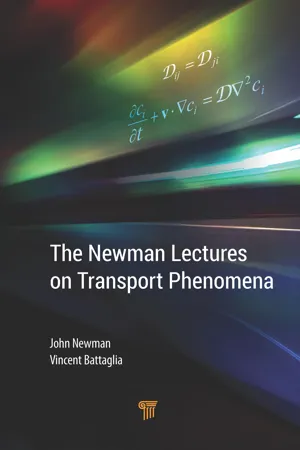
- 314 pages
- English
- ePUB (mobile friendly)
- Available on iOS & Android
The Newman Lectures on Transport Phenomena
About This Book
Prof. Newmanis considered one of the great chemical engineers of his time. His reputation derives from his mastery of all phases of the subject matter, his clarity of thought, and his ability to reduce complex problems to their essential core elements. He is a member of the National Academy of Engineering, Washington, DC, USA, and has won numerous national awards including every award offered by the Electrochemical Society, USA. His motto, as known by his colleagues, is "do it right the first time." He has been teaching undergraduate and graduate core subject courses at the University of California, Berkeley (UC Berkeley), USA, since joining the faculty in 1966. His method is to write out, in long form, everything he expects to convey to his class on a subject on any given day. He has maintained and updated his lecture notes from notepad to computer throughout his career. This book is an exact reproduction of those notes.
This book demonstrates how to solve the classic problems of fluid mechanics, starting with the Navier–Stokes equation. It explains when it is appropriate to simplify a problem by neglecting certain terms through proper dimensional analysis. It covers concepts such as microscopic interpretation of fluxes, multicomponent diffusion, entropy production, nonnewtonian fluids, natural convection, turbulent flow, and hydrodynamic stability. It amply arms any serious problem solver with the tools to address any problem.
Frequently asked questions
Information
SECTION B:
LAMINAR FLOW SOLUTIONS









Table of contents
- Cover
- Half Title
- Title Page
- Copyright Page
- Table of Contents
- Introduction
- Section A: Basic Transport Relations
- Section B: Laminar Flow Solutions
- Section C: Transport in Turbulent Flow
- Appendix A: Vectors and Tensors
- Appendix B: Similarity Transformations
- Index